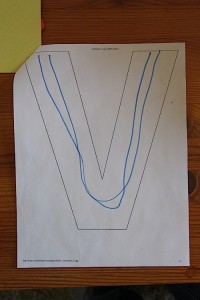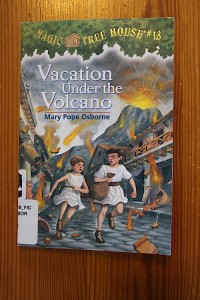The majority of home daycare providers have a group of children of mixed ages and abilities. The wider the span between the ages of your daycare children the more challenging it can be at times to find activities that suit everyone. It can be overwhelming to try to prepare and teach several different learning activities to make sure each activity is perfectly suited for each child.
I find it works best to prepare one activity and then adjust it to fit each child. Once you get the hang of altering activities to make them easier or more challenging, it will become something you do without a lot of extra effort or planning.
You probably already adjust the environment in steps to accommodate each child. For example, your young children need a high chair to eat snack, others probably only need a booster seat and others might prefer to use a regular chair while they rest on their knees. The chair height has been slightly modified for each child to give them the most comfortable eating environment. We will do the same scenario with activities.
Start by focusing your activity to fit the ability level of the middle range of your group. The children in the middle range should need no adjustments for your activity. You will then simplify the activity for your younger children and make it more challenging for your older ones.
Beading Example:
Let’s look at a common fine motor activity for young children- Lacing Beads. Threading large beads onto a lace is a great activity for the average three year old. Here is a three year old child successfully engaged with the activity independently. No adjustments needed.
Younger Children
When you simplify the activity for your younger children, you need to start by thinking about what they can already accomplish independently and where their interests lie. My one year old was keen to try lacing the large beads with my help. Sitting beside a younger child and physically helping them with the materials is the simplest way to adjust the activity. A second option is to alter the materials for their dexterity. Instead of threading the large wooden beads you could cut toilet paper tubes into thirds to create your own jumbo beads.
Understanding each child’s developmental level in relation to attention span is also very important. One year olds like to move and they are in a self-directed discovery phase. I simply had to give my one year old the beads and the laces (with supervision) and see where his own interests lead him. He decided to transport all the beads to the top of the car garage toy and then push each one down the twisting ramp to see if it slid or not. This is a perfect example of a child interacting with an activity at their own interest level and learning a ton in the process.
Older Children
You might have a child who is slightly older and is ready for the activity to be a bit more challenging. I suggested this child thread beads onto her lace in a pattern. She worked on her fine motor control and also practiced some preschool math patterning-circle, square, circle, square.
Our one year old’s antics during this activity gave me another idea. We decided to group our beads into two different categories. Beads that rolled and ones that only slid. Therefore, another way to extend an activity is to use the same materials but challenge a child to experiment with them in a different way and come to a new discovery.
Much Older Children
I also homeschool my own child who requires me to stretch activities to meet her academic needs. I noticed the threading blocks had numbers and dots on one edge of them. She worked on recognizing the dot pattern number and then counted to self-check. When she had them all figured out she threaded them in order from greatest to least. She also made up a few number sentences (addition and subtraction) using the beads.
Letter “V” Example:
My three year olds are currently learning how to recognize and print the letter “V”. When the preschoolers are doing their printing practice the one year old joins us at the table and experiments with the craft supplies. He colours, paints, glues and sometimes just crumples paper to his enjoyment. Having a chance to interact with the materials and watch the preschoolers at work is an excellent opportunity for him developmentally.
“V” is for volcano so we decided to mix baking soda and vinegar to create some lava. The younger children were enthralled to watch the experiment and learn the new term ‘lava’.
The older children had some “why” questions about volcanoes after participating in the volcano experiment. Extra information is a great way to extend an activity for older children. We read this kid’s magazine article about volcanoes together to answer some of their questions.
I extended the volcano theme further for my oldest child and we read this chapter book about the Roman Empire and the city of Pompeii.
Adjusting activities to meet the needs of your daycare children will take a bit of thought at first. Watch how each child responds to the activity and you will be able to gauge if your accommodations were appropriate or not. If the child seems frustrated or uninterested then you know further accommodations are needed.
Often it is the children’s requests and questions that will help you extend an activity for older kids. Allow the child’s interests and stage of development lead you when you decide how to simplify an activity for younger children.
Easter Egg Game Example:
I wrote an Easter Egg Letter Game post last year and explained how to adjust the game into four different skill levels. Even when you have children who might be similar in age they may not all be at the same skill level for a variety of different activities. Read more about our Easter Egg Game here.
Adjusting your activities so that all the children are challenged and intrigued creates a peaceful daycare environment. It’s a pleasure to see my daycare kids focused and fulfilled during our weekly activities.
May your activities bring a bit of joy to your little ones and yourself!











 I’m a former elementary school teacher, and homeschool mother of two, who runs a Waldorf inspired home childcare/preschool.
I’m a former elementary school teacher, and homeschool mother of two, who runs a Waldorf inspired home childcare/preschool.  Sign up now for my newsletter to receive my free "Home Daycare Curriculum."
Sign up now for my newsletter to receive my free "Home Daycare Curriculum."